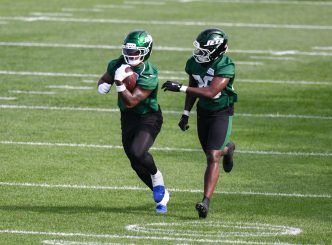The Pittsburgh Steelers’ decision to trade wide receiver George Pickens to the Dallas Cowboys on May 7, 2025, has sent shockwaves through the team’s fanbase, with many expressing outrage over what they see as a lopsided deal. In exchange for Pickens and a 2027 sixth-round pick, Pittsburgh received a 2026 third-round pick and a 2027 fifth-rounder—a return that has fans questioning the team’s direction and fuming over the loss of a dynamic young talent. While some defend the move as a necessary step to move on from a controversial player, the majority are livid, flooding social media and fan forums with frustration over a trade that leaves the Steelers’ offense dangerously thin.
A Trade That Stings Steelers Nation
Pickens, drafted in the second round out of Georgia in 2022, was a polarizing yet electrifying presence in Pittsburgh. His 174 receptions for 2,841 yards and 12 touchdowns over three seasons, including a 2023 campaign where he led the NFL with 18.1 yards per catch and amassed 1,140 yards, made him a cornerstone of the passing game. His acrobatic catches and big-play ability endeared him to fans, who saw him as a potential WR1 for years to come. However, his tenure was marred by off-field issues, including a 2024 incident where he wore eye black with the message “OPEN F—ING ALWAYS” during a game against the Cowboys, and on-field penalties that drew public criticism from coach Mike Tomlin.
The trade came after Pittsburgh’s acquisition of DK Metcalf from the Seattle Seahawks in March, signaling a reshaping of the receiver room. With Pickens’ rookie contract nearing its end in 2025 and extension talks stalled, GM Omar Khan opted to move the 24-year-old rather than navigate a potentially contentious contract year. The Cowboys, needing a complement to CeeDee Lamb, jumped at the chance to pair Pickens with Dak Prescott, bolstering their aerial attack.
Why Fans Are Seeing Red
For many Steelers fans, the trade is a gut punch. The team’s receiver corps is now a glaring weakness, with Calvin Austin III (548 yards in 2024) as the top returning wideout behind Metcalf. Rookie Roman Wilson, a 2024 third-rounder, missed his entire first season due to injuries, and veterans like Robert Woods and Ben Skowronek lack the upside to fill Pickens’ shoes. Fans argue that a third-round pick and a late-round swap is a meager return for a player of Pickens’ caliber, especially given his youth and proven production despite inconsistent quarterback play from Kenny Pickett, Justin Fields, and Russell Wilson.
Social media reflects the anger. One fan posted on X, “A third-rounder for George Pickens? We’re throwing away a star for scraps!” Another wrote, “Traded Pickens after getting Metcalf, and now our WR room is a dumpster fire. What’s the plan, Omar?” The move has heightened concerns about the Steelers’ offense, already reeling from the offseason losses of Najee Harris and Wilson. With Aaron Rodgers a potential 2025 signing, fans fear the team is squandering a chance to build a competitive roster around a veteran quarterback.
The timing of the trade adds fuel to the fire. Pittsburgh passed on drafting a receiver in 2025, despite rumors that Pickens was on the block. Many expected him to play out his contract year, either boosting his trade value or proving his worth for an extension. Instead, the deal feels like a hasty exit, leaving the Steelers with limited options to replace his production in a passing game that ranked 25th in yards in 2024.
The Logic Behind the Move—and Why It’s Falling Flat
The Steelers’ decision to trade Pickens stems from his off-field behavior and questions about his long-term fit. Tomlin’s public call for Pickens to “grow up” after two unsportsmanlike conduct penalties in a 2024 game against the Bengals highlighted ongoing concerns. Incidents like arriving late for a Christmas Day game against the Chiefs and clashing with fans and opponents further strained his standing. With Metcalf signed to a long-term deal, the front office saw Pickens as expendable, unwilling to risk a disruptive contract year or commit to a costly extension.
The trade also reflects Khan’s focus on future flexibility. The 2026 third-round pick provides draft capital to address needs like quarterback or offensive line, and moving Pickens avoids a potential locker-room distraction. Some argue that if Tomlin, known for managing strong personalities, couldn’t connect with Pickens after three years, the relationship was untenable.
But for fans, these justifications don’t cut it. The Steelers’ offense is now a patchwork, with unproven players like Austin and Wilson, or aging free-agent options like Keenan Allen, as the likely replacements. The current quarterback group—Mason Rudolph, Skylar Thompson, and rookie Will Howard—lacks the pedigree to elevate a depleted receiver room. Fans worry that without Pickens, the passing game will stagnate, undermining any chance of a playoff push in 2025, even if Rodgers signs.
A Fanbase Split and a Team at a Crossroads
Not every fan is up in arms. Some support the trade, citing Pickens’ immaturity as a liability. One X post read, “Pickens was a drama machine. Metcalf’s a leader, and we got picks to rebuild. Good move.” Others note that the locker room reportedly embraced Pickens’ energy, making his departure a tough pill to swallow.
The trade has amplified broader anxieties about the Steelers’ direction. After years of hovering around 9-10 wins, fans are desperate for a clear path to contention, not a roster that feels like a step back. Meanwhile, Cowboys fans are celebrating, hailing the deal as a steal that gives Prescott a dangerous new weapon alongside Lamb.
As Pittsburgh looks to 2025, the Pickens trade has become a flashpoint. For every fan who trusts Khan and Tomlin to navigate this transition, another sees the move as a baffling misstep that weakens an already fragile offense. With Rodgers’ decision pending and a thin receiver group, the Steelers face a make-or-break season—one that will either quiet the outrage or prove the doubters right. For now, Steelers Nation is left grappling with the loss of a homegrown star and the uncertainty of what comes next.






